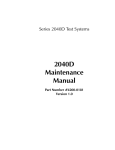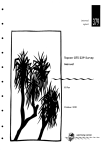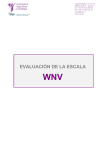Download Apogee ETHCX1 Specifications
Transcript
ETHCX1 INTERFACE CONTROLLER MODULE MODEL 2020 ETHCX1 INTERFACE CONTROLLER MODULE May 25, 2004 TABLE OF CONTENTS 2020.1 INTRODUCTION......................................................................................................... 2 2020.1.1 PURPOSE OF MODULE....................................................................................... 2 2020.1.2 MODULE OVERVIEW ......................................................................................... 2 2020.1.3 FEATURES ............................................................................................................ 3 2020.1.4 SPECIFICATIONS................................................................................................. 3 2020.2 INSTALLATION.......................................................................................................... 3 2020.2.1 MODULE PLACEMENT CONSIDERATIONS................................................... 3 2020.2.2 CABLES ................................................................................................................. 3 2020.2.3 JUMPER SETTINGS ............................................................................................. 4 2020.3 OPERATION AND SETUP......................................................................................... 4 2020.3.1 FRONT PANEL OPERATION.............................................................................. 4 2020.3.2 ETHERNET PORT OPERATION ......................................................................... 5 2020.3.3 ETHCX1 COMMAND SUMMARY ..................................................................... 5 2020.3.4 TYPICAL PROGRAMMING SEQUENCE: ......................................................... 9 APOGEE LABS, Inc. AL4300 Series 5.25.04 2020-1 INTERFACE CONTROLLER MODULE ETHCX1 MODEL 2020 ETHCX1 INTERFACE CONTROLLER MODULE 2020.1 INTRODUCTION 2020.1.1 PURPOSE OF MODULE The Apogee Labs Model 2020 ETHCX1 module provides a remote control facility for a AL4300 Series chassis using an Ethernet 10/100 Base-T link. This facility supports all the remote control commands listed in the individual manuals for the AL4300 modules installed in the chassis. These commands are ASCII coded control and status interrogation commands, each of which are individually Acknowledged. This is designated as the Network Native ASCII Transfer or NNAT remote control mode. 2020.1.2 MODULE OVERVIEW The control processor on the ETHCX1 receives incoming data from the Ethernet. Completed commands received are then sent to the Front Panel Controller of the chassis via the internal ALISDT bus. The Front Panel Controller in turn directs the data to the selected module. This target module processes the command and provides a response back to the Front Panel Controller, which forwards this to the ETHCX1. The ETHCX1 holds the response until interrogated from the Ethernet. The ETHCX1 setup consists of assigning the IP Address, Netmask, and Gateway on the ETHCX1 by way of the Ethernet. Initial access to the module is made using the default values indicated in Table 2. Once set, the values are retained in the non-volatile memory on the card and are restored during each unit power-on sequence. The following block diagram shown in Figure 1 presents a simplified overview of this module: RJ-45 2 3 6 TX + TX - RX + Ethernet Magnetic Matching Network ETHERNET FRAMER u Controller Bus Interface ALISDT 1 RX - Figure 1 - ETHCX1 Simplified Block Diagram 2020-2 AL4300Series 5.25.04 APOGEE LABS, Inc. ETHCX1 INTERFACE CONTROLLER MODULE 2020.1.3 FEATURES • Standard single slot AL4300 module • Slot-independent operation • Automatically replaces existing remote control • Complies with 10/100 base-T Ethernet operation • Fully supports Apogee Labs standard full duplex remote control protocol • Switch-enabled automatic reset of default IP address setting 2020.1.4 SPECIFICATIONS • Compliant with IEEE 802.3 / Ethernet V.2 • 10/100 Base-T operation • RJ-45 connector • Full Duplex Operation • Supports TCP/IP, UDP and Apogee Labs NNAT • Occupies one AL4300 chassis slot 2020.2 INSTALLATION 2020.2.1 MODULE PLACEMENT CONSIDERATIONS The ETHCX1 plug-in module may be placed anywhere within the AL4300 series chassis. The front panel processor, which interrogates the backplane to determine the presence of modules upon the initial application of power to the unit, recognizes this module as the default remote control device. 2020.2.2 CABLES The following figure illustrates the only connection to be made: Figure 2 - ETHCX1 Front and Side Panel Views APOGEE LABS, Inc. AL4300 Series 5.25.04 2020-3 INTERFACE CONTROLLER MODULE ETHCX1 Two pairs of unshielded twisted-pair wire are used in 10/100 BaseT applications. The connector pin assignments are shown below in Table 1. Table 1 - ETHCX1 Module RJ45 Network Interface Connector (J1) Signal Pin List PIN 1 SIGNAL TX+ DESCRIPTION Transmit+ PIN 3 SIGNAL RX+ DESCRIPTION Receive + 2 TX- Transmit - 6 RX- Receive - 2020.2.3 JUMPER SETTINGS There are no jumpers settings on the module that affect its operation. One switch (see SW1 location on Figure 2) is used to initialize the module IP address, Net Mask and Gateway to the factory defaults (Table 2). Should it be necessary to reset these to the factory defaults, the following procedure should be followed: 1. Turn off the power to the AL4300 chassis. 2. Remove the ETHCX1 module, locate SW1 and set it to “Reset IP Address”. 3. Replace the module in its card slot. 4. Restore power to the chassis. 5. After approximately 5 seconds, turn off the chassis power. 6. Remove the module and reset the SW1 position to “Operating”. 7. Replace the module in the chassis and restore power. Table 2 - Factory Default IP Address Settings FUNCTION IP Address Netmask Gateway 2020.3 IP ADDRESS 192.168.0.10 255.255.255.0 192.168.0.1 OPERATION AND SETUP ETHCX1 Modules are designed so that the user never needs to install new or upgrade old “system setup software”. Configuration of the AL4300 is done through either the front panel or a remote control link. NNAT (Network Native ASCII Transfer) communications is used to control and monitor the AL4300 on an Ethernet connection. When a new channel module is installed, all the needed setup software for that module is contained on the module. The ETHCX1 provides a transparent communication path to a remote control computer. 2020.3.1 FRONT PANEL OPERATION The ETHCX1 module does not support nor require operation at the front panel of the AL4300. 2020-4 AL4300Series 5.25.04 APOGEE LABS, Inc. ETHCX1 INTERFACE CONTROLLER MODULE 2020.3.2 ETHERNET PORT OPERATION Operation and Set Up of the ETHCX1 module is made as follows: Verify that the default network settings listed in Table 2 are compatible with the standalone PC or network to which connection is to be made. If the default settings are not compatible with the network computer, change the network settings in accordance with the procedure as follows: 1. Connect the Client software application to the current IP address of the module. 2. Change the current settings to the new settings using SET commands in the ETHCX1 configuration mode. 3. Issue the CONFIRM IP instruction. Once compatible network settings are made, refer to the Network Control Procedure below to access and configure the installed AL4300 modules using a client program of choice. It should be noted that the RS232 control port on the AL4300 is unusable when the ETHCX1 interface is installed 2020.3.3 ETHCX1 COMMAND SUMMARY 2020.3.3.1 The CONTROL Command The CONTROL command is used to access the ETHCX1 module. It is only after issuing this command that the IP address parameters associated with this module may be viewed using the READ command or changed using the SET command. It should be noted that connection to this module must be established first. This is possible using client software such as that described in section 2020.4. The syntax of this command is: CONTROL=ETHCX1<CR> > If the command CONTROL<CR> is issued, the response is: ETHCX1<CR> > To return to controlling the AL4300 modules, the following command is issued: CONTROL=AL4300<CR> AL4300<CR> > 2020.3.3.2 Set Command SET is used to assign values to programmable fields. The SET command has two fields separated by a comma or an “=”,. These are: the parameter name and the parameter value. The following details programming with the allowable field identifiers and values for each. If it is desired to change parameters on a functional module in the AL4300, that module must first be addressed using its slot number. To change an IP parameter on the ETHCX1, first address the module using the CONTROL command. After loading the new IP parameter(s) use the CONFIRM IP command to transfer these values into the working registers. The CONFIRM IP command loads the new IP address and disconnects the server. Connection must be reestablished after this command. APOGEE LABS, Inc. AL4300 Series 5.25.04 2020-5 INTERFACE CONTROLLER MODULE ETHCX1 The valid range for the IP parameters is as follows: Parameter Min Max IP Address 0.0.0.0 255.255.255.255 Net Mask 0.0.0.0 255.255.255.255 Gateway 0.0.0.0 255.255.255.255 Port 1501 65535 Table 3 - Set Command Format SET – Sets parameter values Command Entry Format SET <Parameter Name>=<Parameter Value><CR> System Response for Valid Command <Parameter Name> <Parameter Value><CR>> System Response for an Invalid Command <CR>? Sample Entry SET IP Address=192.168.0.10<CR> System Response- IP Address 192.168.0.10<CR>> Sample Invalid Entry SET IP Address=192.168.010045<CR> System Response ? 2020.3.3.3 CONFIRM IP Command The CONFIRM IP command loads the values given to the module using the SET command for IP Address, Netmask, Gateway and Port into the working registers. If this command is not issued, the IP settings remain unchanged. The connection to the ETHCX1 is disconnected by this command as well. 2020.3.3.4 RESET IP Command The RESET IP command restores the IP settings to the default values. The values set are the same as if the module was powered-up with the IP Address switch in the RESET position and are as follows: IP ADDRESS 192.168.0.10 NETMASK 255.255.255.0 GATEWAY 192.168.0.1 PORT 1501 2020.3.3.5 READ Command READ is used to confirm values of programmed fields and to collect status associated with the currently selected module. The READ command has one argument to designate the field. 2020-6 AL4300Series 5.25.04 APOGEE LABS, Inc. ETHCX1 INTERFACE CONTROLLER MODULE Table 4 - Read Command Format READ – Displays the current parameter setting Command Entry Format READ <Parameter Name><CR> System Response for Valid Command READ <Parameter Name> <Parameter Value><CR>> System Response for an Invalid Command <CR>? Sample Entry READ IP Address<CR> System Response READ IP Address 192.168.0.10<CR>> 2020.3.3.5 SLOT Command The SLOT command is required to permit accessing functional modules in the system. After issuing this command the user gains access to the functions of the module contained in the designated card slot. Table 5 - The SLOT Command SLOT – Accesses a selected module by its Slot number in the system Command Entry Format SLOT=<number><CR> System Response for Valid Command ><System Prompt> System Response for an Invalid Command <CR>? Sample Entry SLOT=3 System Response > 2020.3.3.6 [The user programs the module in slot 3] Programming Example A typical example to control a MUX9 module located as slot 3 in the chassis is as follows: >slot=3 >set c1id=023 >set c2id=024 > 2020.3.3.7 HELP Command The HELP command is used to gain insight into the remote instructions associated with a specific module. The command format and acceptable parameter value(s) are returned. The HELP command is issued after selecting a module using the SLOT command. The ETHCX1 response to the HELP command is shown in Table 6. APOGEE LABS, Inc. AL4300 Series 5.25.04 2020-7 INTERFACE CONTROLLER MODULE ETHCX1 Table 6 - HELP Response from ETHCX1 HELP – Displays each parameter with the range of possible settings Command Entry Format HELP<CR> System Response for Valid Command ><Displays Help Screen> System Response for an Invalid Command <CR>? Sample Entry System Response 2020.3.3.8 >help<CR> HELP ETHCX1 1.0 (1.0 ) SET/READ IP ADDRESS SET/READ NETMASK SET/READ GATEWAY SET/READ PORT CONFIRM IP RESET IP CONTROL=ETHCX1, AL4300 > EXIT command At the conclusion of a session the ETHCX1 may be disconnected by issuing the EXIT command. >EXIT Server has been disconnected > 2020-8 AL4300Series 5.25.04 APOGEE LABS, Inc. ETHCX1 INTERFACE CONTROLLER MODULE 2020.3.4 TYPICAL PROGRAMMING SEQUENCE: The User Logs onto the ETHCX1... [user@localhost userhome]$ ./client -i 192.168.0.10 -p 1501 Connecting to 192.168.0.10 Connected. The User Switches to Configure Mode for the ETHCX1... >CONTROL=ETHCX1 ETHCX1 The User types "Help" to get the ETHCX1 commands... >HELP HELP ETHCX1 1.0 (1.0 ) SET/READ IP ADDRESS SET/READ NETMASK SET/READ GATEWAY SET/READ PORT CONFIRM IP RESET IP CONTROL=ETHCX1, AL4300 The User 'reads' the IP settings of the ETHCX1... >READ IP ADDRESS IP ADDRESS 192.168.0.10 >READ NETMASK NETMASK 255.255.255.0 >READ GATEWAY GATEWAY 192.168.0.1 >READ PORT PORT 1501 APOGEE LABS, Inc. AL4300 Series 5.25.04 2020-9 INTERFACE CONTROLLER MODULE ETHCX1 The User changes the IP settings... >SET IP ADDRESS=192.168.0.152 IP ADDRESS 192.168.0.152 >SET NETMASK=255.255.255.1 NETMASK 255.255.255.1 >SET GATEWAY=192.168.0.2 GATEWAY 192.168.0.2 >SET PORT=1502 PORT 1502 The User saves the configuration settings... >CONFIRM IP Server has been disconnected. The User reconnects to the ETHCX1... [user@localhost userhome]$ ./client -i 192.168.0.152 -p 1502 Connecting to 192.168.0.152 Connected. The user addresses the module in slot 5 and issues its help command... >slot=5 >help DLTM REGISTER:DATA CLOCK: Internal,External BIT RATE: 100 - 35000000 (etc.) The User disconnects from the ETHCX1... >exit Server has been disconnected. 2020-10 AL4300Series 5.25.04 APOGEE LABS, Inc.



















